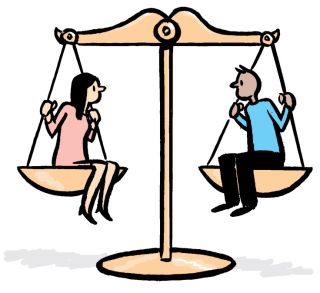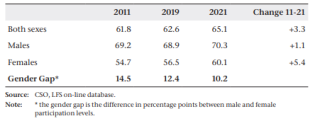Gender Gaps still a reality on International Women's Day 2023

Today, 8th March 2023, is International Women's Day. Eurostat have released a number of articles examining gender gaps in employment and pay across the EU.
Gender gap in self-employment rises with age
Data from Eurostat [1] shows that in Q3 of 2022, men in employment in the EU were more likely to be self-employed than women. 16.1 per cent of employed men were self-employed compared with just 9.4 per cent of women. Educational attainment level was found to be a factor with the gender gap between people aged between 15 and 64 who were self-employed was the largest among employed people with a low educational level (8.4 percentage point (pp) gap), followed by those with a medium level (7.2 pp gap) or a high level of education (5.8 pp gap). Age was also a factor with the gender gap increasing from a difference of 5.7 pp for those aged between 25 and 49 to 9.9 pp for people aged between 50 and 64.
The widest gender gaps in self-employment were found in Greece (12.2 pp), Slovakia (11.3 pp) and Malta (10.6 pp) with high values also foind in Poland (9.8 pp), Ireland (9.7 pp) and Italy (9.1 pp). The smallest gaps were found in Cyprus (1.4 pp), Luxembourg (2.2 pp) and Lithuania (3.7 pp).
Gender gap for income narrower in rural areas
Eurostat [2] report the gender gap across the EU for median equivalised net income was close to 5 per cent during the previous decade. In 2021, in absolute terms, the median value for males was €18,774 which is almost €800 higher than the one for females, €17,972. When differences in the levels of urbanisation were taken into account, the EU gender gap for net income was narrower for people living in rural areas than for those living in cities, 4.0 per cent versus 4.8 per cent.
Among the 14 countries where income gaps were higher in rural areas rather than cities, Austria (5.3 pp) and Italy (4.2 pp) presented the largest differences between the income gender gaps observed in urban and rural areas. Interestingly, in Austrian cities and Maltese rural contexts, the income gap was found to be in favour of females: -1.7 per cent and -4.4 per cent respectively.
More women work part-time than men
Eurostat [3] data from across the EU for Q3 of 2022, shows that the share of female part-time workers in total female-employed people aged 15-64 was 28 per cent higher than the share of men (8%). In elementary occupations (defined as helpers, cleaners or food preparation assistants amongst others [4]) 48 per cent of women in were part-time workers compared with 19 per cent of employed men. Part -time service and sales workers were 35 per cent women and 15 per cent men.
The lowest difference between the shares of part-time workers in the female and male employment were registered in the managerial occupations (10 per cent women against 3 per cent men).
Boosting Labour Force Participation
Increasing labour force participation, in particular among women, represents a further policy challenge for labour market policy. As Table 1 illustrates, the proportion of individuals who are actively participating in the labour market has increased since 2011 and 2019. However, these rates are still lower than ideal with in particular female labour market participation well below the levels it should be reaching. The gender gap, of ten percentage points, illustrates this outcome quiet clearly. Policy responses to this challenge need to be broad-based, and include initiatives addressing childcare provision and affordability, retraining, family-friendly employment strategies and enhanced employment quality. It is important that we remember these participation rates, and the challenges they imply, as we review priorities for any further recovery in employment and decreases in unemployment in the period ahead.
Table 1: Labour Force Participation Rates by Gender, 2011-2021

Increase investment in early childhood education and care and after-school care
Affordable childcare and child-friendly employment arrangements are key requirements for greater labour participation among young mothers [5]. Cost is also key in keeping women in the workplace with many working women citing childcare costs as a reason to consider leaving the workplace. High childcare costs present a barrier to employment, particularly among young women with children. An increase in the cost of childcare led to a decrease in the number of paid working hours for mothers. An increase in the cost of provision of just 10 per cent could lead to a 30 minute reduction in a mother’s working hours [6].
[1] https://ec.europa.eu/eurostat/en/web/products-eurostat-news/w/edn-20230…
[2] https://ec.europa.eu/eurostat/en/web/products-eurostat-news/w/edn-20230…
[3] https://ec.europa.eu/eurostat/en/web/products-eurostat-news/w/edn-20230…
[4] https://www.ilo.org/public/english/bureau/stat/isco/index.htm
[5] https://www.oecd-ilibrary.org/social-issues-migration-health/society-at…
[6] https://www.esri.ie/publications/maternal-employment-and-the-cost-of-ch…